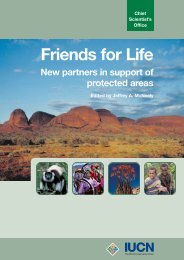Exchange programmes - IUCN
Exchange programmes - IUCN
Exchange programmes - IUCN
Create successful ePaper yourself
Turn your PDF publications into a flip-book with our unique Google optimized e-Paper software.
Implementation of an <strong>Exchange</strong> Programme for Protected Areas in East Asia<br />
other by the agency, office or university that employs this person. This technique has<br />
allowed NOAA to stretch the limited funds available.<br />
Core programme funding<br />
Both NOAA and SOA devote staff time and expenses to support the partnership. The<br />
NOS office has three permanent staff workingin China, Korea and Japan. The NOS<br />
International Program Office has a budget of $40,000. The money is pooled with other<br />
partners to build the overall programme and is also used for administrative costs for<br />
planning meetings with the Chinese. NOS consider the $40,000 to be core funding, but it<br />
is not a fixed amount every year. Budget allocation priorities change from year to year<br />
and cannot be guaranteed.<br />
The programme hopes to involve other potential donors like the World Bank and the<br />
GEF in the future. They also hope to work more closely with groups such as <strong>IUCN</strong>,<br />
WWF and the China Environment Fund to help access further expertise in the region and<br />
additional fundingfrom corporate donors and other sources. They are also workingmore<br />
with other governmental organisations in the Environment Protection Agency and the<br />
Department of Interior to co-ordinate efforts and investment in areas of common<br />
concern.<br />
Lessons learned<br />
NOAA considers this agreement with China to be the strongest bilateral agreement they<br />
have, enablingthem to build strongrelations with the Chinese ocean and coastal<br />
community based now on over 20 years of collaboration. If one conclusion can be drawn<br />
from this experience, it is the importance of continuity. To maintain the partnership it is<br />
vital for the two sides to continue communicatingand to continue to work together on<br />
partnership objectives. To this end, after their visit, the Chinese worked as a team back in<br />
China to continue implementingthe planningprocess begun in the US.<br />
2.4 Italy-United States Park and Protected Area Twinning/Partnership<br />
Introduction<br />
American interest in Italy’s parks dates back as far as the 1930s, when American experts<br />
travelled to Italy to observe Italian land management, reforestation, erosion control<br />
methods and the successes of their conservation corps (Bray, 1998). The idea of twinningItalian<br />
and American protected areas was first recommended by Italian individuals<br />
in the 1990s. Over time, interest in partneringintensified in both countries.<br />
Italy United States<br />
1. Abruzzo National Park Adirondack Park<br />
2. Po Regional Nature Park Hudson River Valley Greenway<br />
3. Pisa Regional Parks Long Island Pine Barren<br />
4. Parco Val d’Orcia Mohawk Valley Heritage Corridor<br />
5. Parco Litorale Roman Hudson Mohawk Urban Cultural Park<br />
In 1997, a roundtable discussion was held on the linkingof Italian and US parks and<br />
protected areas. This initiated the twinning/partnership process. Since then the partner-<br />
34






